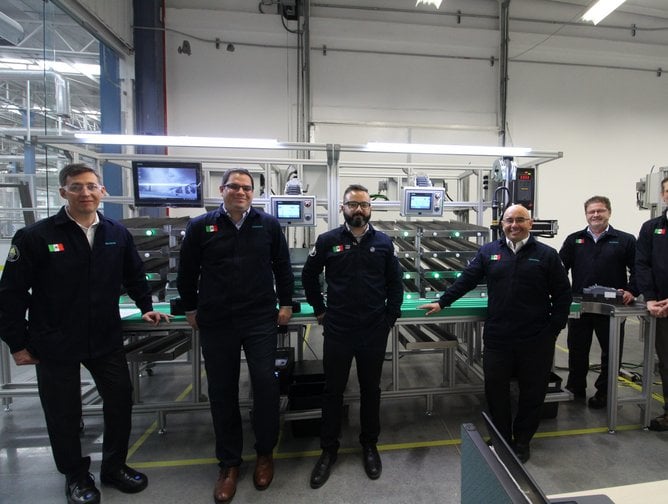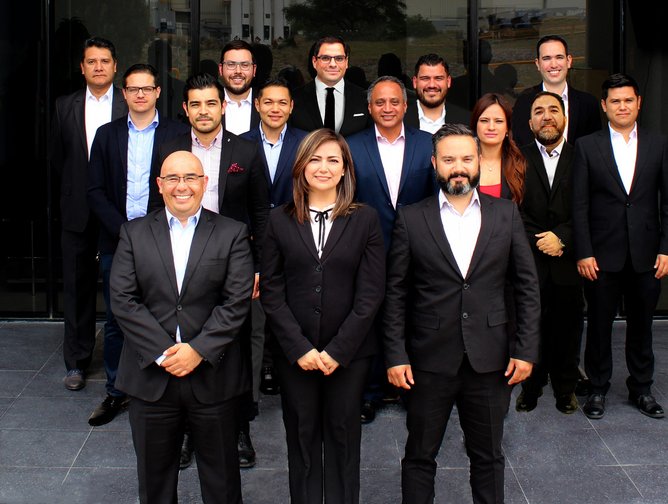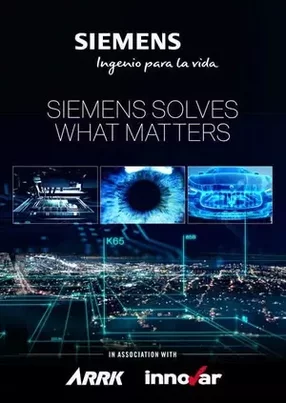Siemens enjoys a privileged position as one of today's leaders in the industries of technology, healthcare, and solutions for the processes of electrification and digitalisation.
Siemens may be defined as an actor that understands what truly matters in today's society: the extreme urbanisation of the planet, globalisation, digitalisation, climate change, and the ageing of the population are some of the hot topics for which Siemens creates solutions that leverage change. All this is focused on the creation of a catalogue and implemented in three cornerstones: automation, electrification, and digitalisation. Its production plant in Monterrey (Mexico) is going through a digitalisation renewal process that is making its manufacturing processes more agile and efficient - it's truly a factory from the future.
Homero Javalera, director of Operations in Siemens Mexico, has been at the forefront of the plant's operations for four years, a labour that has earned him awards as renowned as the Global Siemens AG Award 2016 (Werner von Siemens Award) for the best global performance, the biggest recognition awarded by Siemens in the entire corporation.
The combination of two business areas
The most relevant development that Javalera may have had in his administration to date has been the fusing together of two production plants into today's Monterrey plant, where work is done in three different areas. "I took care of the transfer of two business areas and the coordination of the whole team, a task that consisted of building warehouses, hiring 1,000 people, implementing ERP (Enterprise Resource Planning), redirecting the entire supply chain and all the suppliers, contacting internal clients and investors, buying new equipment, etc. We have 1,500 employees in the factory, and we sell approximately $220mn and over 20mn units per year."
Javalera delves into the plant creation process: "What we did was bring two factories together into one - we had a single type of product here, and then, we brought over two more from two different factories. Now, we have three types of products in Monterrey: residential circuit breakers, industrial circuit breakers, and safety switches," Javalera analyzes. "This isn't just a manufacturing facility; it's an Investigation and Development center as we design and launch new products here as well. We have a group of researchers conducting advanced materials investigations using nanotechnology, and another group doing Investigation and Development with the supply chain group from Global Procurement in the areas of automation and digitalisation here in this organisation as well."
"This is truly a company doing complex things, a company facing today's most complex challenges. It generates technology to address issues such as climate change, energy distribution, clean energy generation... our portfolio is vast in that sense. We also address the issue of the planet's extreme urbanisation, and to do so, Siemens’s catalogue serves, for example, mobility, trains, smart buildings, and energy consumption control in urban concentrations. We have the opportunity to contribute that to our clients. Digitalisation is a global trend and a priority for Siemens. Through our portfolio, we provide solutions for our clients, and we're also developing our internal systems. For example, we've grown very much in comparison to previous years with clients such as Amazon, Facebook, and Microsoft given the investments they've made in infrastructure such as data centers. The world is going electric, and Siemens has this whole catalogue."
Digital transformation from the inside
Siemens Mexico doesn't create innovation for its clients only, but it also applies it to its production processes. The radical changes in the plant's production lines were a result of introducing the most relevant trends in digitalisation to maximise resources. Javalera explains how this change developed. "The change has been exponential in the last years, not so much before then. Ten years ago, we made very slow changes as needs would arise and according to the available technology. Now, we have a deeper understanding of digitalisation and automation; technology is more readily available, and new generations are entering the labour market with different skills in digitalisation."
"Change in the past three or four years has been exponential indeed since, 10-15 years ago, we hadn't done what we've been doing lately. For example, mobile technology already existed then, but today, new communication protocols in mobile technology allow for the exchange of data in massive amounts and at unbelievable speeds. This way, data from thousands of connections in your production lines may be connected in real time and be used in a very valuable way."
Siemens Mexico has its own team of experts in charge of leading the transition and application of digital technologies: "Digital Factory is our division leading us through the digitalisation process - they have the entire portfolio, and it's quite vertical. It includes the physical elements necessary to connect the machines and generate data as well as the elements for interconnectivity and industrial networking purposes. Our Siemens PLM division has an entire software portfolio for the different stages in our digitalisation, and it also has the design software Siemens NX to create digital twins of industrial processes and/or products such as cars, airplanes, circuit breakers, etc."
By executing a circular strategy, Siemens uses these same digital processes to leverage the efficiency of the products it offers to market. "For example, you can monitor the efficiency of our electricity generation turbines in real time. You can monitor the efficiency of the electric distribution and make decisions on the spot. Also in real time and through customised solutions tailored to your needs, you can monitor and distribute energy in a smart way in cities and buildings. Even at the production line level, through Siemens's portfolio of software and hardware, you can know which engine is consuming more energy, or you can know what the peak times of energy consumption are in a smart building to implement energy-saving projects," he concludes.
Innovation applied to manufacture processes
In Siemens's Mexico particular case, the application of digital innovations is accomplishing a very high level of satisfaction with processes, production, and manufacturing. Javalera offers exclusive information on this newly obtained acceleration: "We can save on months of prototype development, long hours of engineering, and lots of money in materials and tools by simply creating digital twins for the products before launching them."
"Before ordering new machinery and investing hundreds of thousands of dollars in equipment, simulations are designed by computer right at the production line to determine what is really needed. This saves up thousands of dollars by preventing potential failures from errors in the design of the productions lines. Moreover, once it's running, you can make sure its efficiency is as close as possible to the efficiency you expect from production, emphasising automatic management of the client's demands, where we have much less human intervention."
In matters of production execution, we monitor the performance of the lines in real time, and we receive an immediate response whenever a problem arises. Regarding quality and product safety, in very critical processes, we accomplished having deep and detailed traceability at an individual level for each of the 30 million units we make every year. We have a "birth certificate" for every one of them, a matrix code that is unique for every product. All of that is available in the cloud, and we can make inquiries, analyse, improve, monitor, etc. through applications."
"For machine maintenance, we're installing additional sensors, connectivity modules, HMIs, and PLCs. We are getting them connected so they can let us know in a predictive way when we need to do a maintenance intervention so the machine won’t fail. In the future, we're moving up to a prescriptive level in such a way that the system itself will give instructions, carry out maintenance activities automatically, and even create purchasing orders [for parts] promptly. Whenever the replacement part is ready in the warehouse, it will create and send a maintenance work order to be executed."
Solid alliances with collaborators
Siemens Mexico is proud to offer its avant-garde innovation to clients as renowned as Microsoft, Facebook, BMW, General Motors, and Ford, and this is thanks to its collaboration with top companies as well as with partners and suppliers. This has been evidenced by the recent association of Siemens with Amazon Web Services, the digital giant: "Siemens has an IIoT (Industrial Internet of Things) operative system called MindSphere, and our 3.0 version is in the servers of Amazon Web Services. These servers have a superior processing capability when compared to what we have internally and to what we've seen from other potential partners."
"Amazon's processing capability is brutal; it's very fast, and it can process a huge amount of data simultaneously. Our operative system is installed there. We already started by implementing the first application, and we plan on connecting over 550 pieces of equipment. Every piece of equipment will have at least 10 connection points; that is, over 5,500 connection points that will generate millions of data."
The company also enjoys an excellent collaborative relationship with its suppliers, such as AARK, for example. A specialist in product development, it has been a global supplier of prototypes and production tools for Siemens since 1997, working jointly in many different divisions including Siemens Medical. This year, it has been in charge of the largest version of a toolkit for a single provider.
See also:
- Mercedes-Benz Brazil: reinventing the automotive industry
- How Viacom’s technology transformation is driving a unique entertainment experience
- How Fannie Mae initiated a procurement transformation with a customer focus
In great measure, said collaborations drive digitalisation in Latin American, enriching and leveraging transformation. Javalera analyses the digital disruption situation in the region: "Here, we see it at our operation's level. Job positions are truly changing. The demand for process engineers is decreasing, and so is the demand for data entry clerks, inspectors, etc. However, there is a higher demand for programmers, applications developers, and people who know about automation, PLCs, industrial networks, and big data analysis."
"That is a challenge; there will be a huge demand, and there won't be enough people to fulfill it. We're going to need to hurry up, both the industry and universities, in order to develop the necessary skills. Another important challenge is implementing a big part of the innovation in digitalisation. The industry needs to be more willing to invest and experiment without the burden of traditional accounting. The value is clear, and it does exist, but on occasion, it will be difficult to calculate an immediate return of investment."
Siemens Mexico has defined its strategy to continue transforming itself in the future: "Siemens is migrating towards becoming a company that is thoroughly about digital technology. Regarding software and digital services, we grew 20% last year, with a revenue of over $5.78 billion - Siemens is already the eight largest software company in the world in terms of size. We've acquired over $11.55 billion in software in the last 10 years. We've also increased our investment in investigation and development significantly in the last few years. Almost $7 billion will go to Investigation and Development every year. This includes both the digital and automation areas as well as the areas of additive manufacturing, autonomous robots, blockchain applications, Artificial Intelligence, advanced materials, and energy storage among others.
"In California, we have the Next 47 division, which works as a kind of catalyst for startups. For the next five years, Siemens sets aside $1.16 billion for Next 47, and it's mainly working with 3D printing, IoT, robotics and drones, artificial intelligence, augmented reality, and virtual reality."
"We are not only helping with capital, but Siemens connects these startups with either our partners or with Siemens itself to see how to implement their proposals in the industry. We also get them closer to both the industry and potential clients," concludes Javalera.







